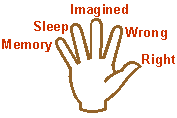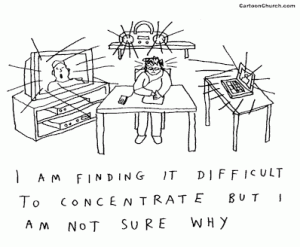To quote Eckhart Tolle, “Not to be able to stop thinking is a dreadful affliction, but we don’t realize this because almost everybody is suffering from it, so it’s considered normal. This incessant mental noise prevents you from finding that realm of inner stillness that is inseparable from being. It also creates a false mind-made self that casts a shadow of fear and suffering.”
To put things in proper perspective takes real intelligence (Buddhi – to be awake; to understand; to know), not more mind chatter. Then it is possible to realize that thought is only a tiny aspect of our intelligence. Tolle goes on to say: “All the things that truly matter – beauty, love, creativity, joy, inner peace – arise from beyond the mind.”
The obsessive thinking mind and yoga practice – a bad mix
When the ego-self (established by the thinking mind) is the one performing asana, the mind is actively engaged in self-criticism, comparing your performance with others, thereby judging yourself and those around you. Your mind becomes restless, agitated and engaged in internal conflict while your body is engaged in performing asanas. This internal conflict causes you to be emotionally reactive to whatever is happening at any given moment during your practice and you are engaged in the posture of ego which is contrary to the purpose of yoga – the deconstruction of the ego.
In the Yoga Sutras (1:2) Patajali defines the purpose yoga by saying, “Yoga means stopping the mental modifications.” (chitta vritti nirodah). There is no exact English translation, but roughly translated these Sanskrit words mean… chitta = stuff of the mind, vṛitti = modification (altering perception) and nirodaḥ = to control (find tranquility).
Basically this means that whatever form of yoga you are practicing, the highest priority and the fundamental purpose for the practice is to eliminate mental agitations and emotional reactions. Whenever performing yoga asanas, it is necessary to change from an ego-driven posture that is externally placing the body in a so-called “yoga asana,” while internally, the mind is engaged in conflict. This equates to practicing conflict and calling it yoga. So it stands to reason that in order to convert this ego driven posture into true yoga asana, you need to remove the ego-mind (which is continually engaged by external motivation).
Whenever a student of yoga is able to connect with the part of themselves that is aware beyond any ego-conditioned perception, they have an opportunity to change their reactions to external circumstances. These “knee-jerk” reactions are automatic and unconscious, arising out of the past (or the anticipated future) and can only be dismantled in the present moment. Even though these unconscious reactions tend to happen automatically, there is a part of us that is conscious and can become a witness, thus changing the reaction. When we are able to change our reaction, we can change from our very core and that will change us from the inside, instead of simply altering our external conditions. This is your divine potential, your inherent “Self”. Accessing this Self (or divine potential) has nothing to do with what we’re doing, but how (or from where) we are doing what we’re doing.
Five kinds of thoughts
According to Patanjali, there are only five kinds of thoughts. Although there are countless thought impressions that come into the field of the mind (chitta), which form the source and substance of the barrier (or veil) covering the true Self (Divine consciousness), they all fall into one or more of these five categories. In other words; while there may be many individual thought impressions, there are not countless types of thoughts to deal with, but only these five. This can help students and practitioners of yoga greatly in seeing the underlying simplicity of the science of Yoga, without getting lost in the apparent multiplicity in both the gross and subtle realms. These five thought impressions are:
 1. Pramana/right impressions (or though
1. Pramana/right impressions (or though
 Samadhi is a Sanskrit word which is the state of consciousness induced by complete meditation, derived from the verbal roots “samā” (the state of total equilibrium) and “dhi” (of a detached intellect).
Samadhi is a Sanskrit word which is the state of consciousness induced by complete meditation, derived from the verbal roots “samā” (the state of total equilibrium) and “dhi” (of a detached intellect).
 Dhyana is a Sanskrit word which means to meditate, derived from the verbal root dhyai, Dhyana it is the most common designation for both the meditative state of consciousness and the yogic techniques by which it is attained.
Dhyana is a Sanskrit word which means to meditate, derived from the verbal root dhyai, Dhyana it is the most common designation for both the meditative state of consciousness and the yogic techniques by which it is attained. Dharana is a Sanskrit word which means immovable concentration of the mind (or that which gives stability”) from the root Dhar, which means to “bind together”, “to make stable”. Dharanais the willful act of concentration of the mind.
Dharana is a Sanskrit word which means immovable concentration of the mind (or that which gives stability”) from the root Dhar, which means to “bind together”, “to make stable”. Dharanais the willful act of concentration of the mind.
